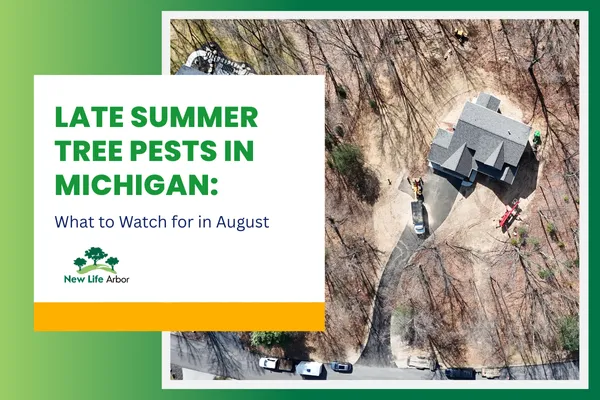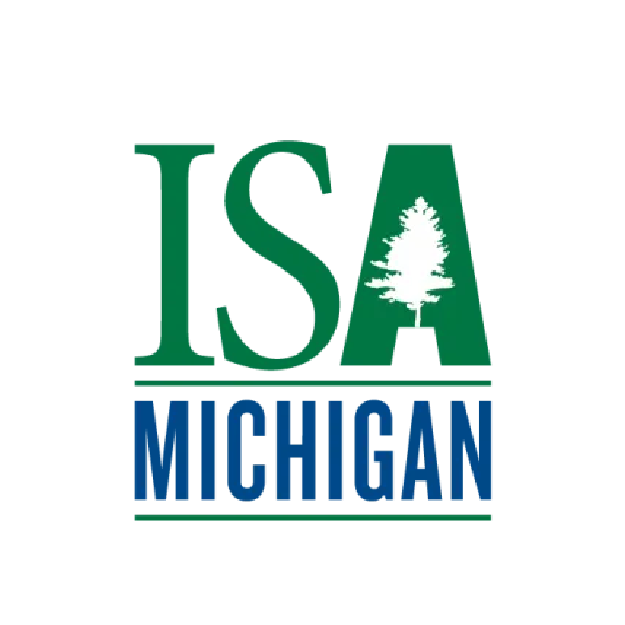
Late Summer Tree Pests in Michigan: What to Watch for in August
As August heats up in West Michigan, you’re not the only one trying to stay cool—tree pests are thriving in this season too.
Late summer is when many harmful insects are at their most active, feeding, laying eggs, or preparing to overwinter in the bark and branches of your trees.
At New Life Arboricultural Services, we get a lot of calls this time of year from concerned homeowners spotting unexpected changes in their trees. And the culprit is often a pest problem that’s been quietly growing all summer long.
Here’s a breakdown of the top late-summer tree pests in Michigan and what you can do about them before they cause long-term damage.

1. Aphids: The Tiny Sap-Suckers
Aphids might be small, but their impact can be big. These soft-bodied insects cluster on leaves and stems, drawing out sap and weakening your trees.
What to look for:
Sticky residue (called “honeydew”) on leaves or nearby cars
Curling or yellowing leaves
A sudden increase in ants (they love aphid honeydew!)
Why it matters in August:
Warm temps accelerate aphid reproduction. An untreated infestation can weaken your tree before fall, making it more vulnerable to other stressors.
Our tip: A strong spray of water can knock aphids off small trees. For larger ones or repeated infestations, a certified arborist may recommend horticultural oils or systemic treatments.

2. Gypsy Moths (Spongy Moths): Hungry, Destructive, and Persistent
These pests are infamous in Michigan for their defoliation power. While their peak feeding occurs earlier in the summer, late July and August are when the damage becomes most noticeable—and when you’ll start spotting their egg masses.
What to look for:
Large patches of stripped leaves, especially on Oaks
Brown, dry leaf clusters
Cream-colored egg masses on trunks, fences, or siding
Why it matters in August:
This is your last chance to remove egg masses before they hatch in spring. Each one can produce hundreds of larvae.
Our tip: Scrape egg masses into a container of soapy water, or call us for safe removal—especially if they’re up high or covering multiple trees.

3. Scale Insects: The Silent Tree Sappers
Scale insects are sneaky. They look like little bumps on bark or leaves, but they’re actually living insects feeding on your tree’s fluids.
What to look for:
Small, shell-like bumps on twigs or stems
Yellowing leaves or stunted growth
Sticky sap or black sooty mold
Why it matters in August:
Many scales enter a vulnerable stage in late summer, making now the best time for treatment.
Our tip: Don’t ignore scale—they’re tough to remove without professional help. We can determine the species and apply the right treatment at the right time.

4. Emerald Ash Borer: Still Threatening Michigan Trees
Though first discovered in Michigan over 20 years ago, Emerald Ash Borer (EAB) continues to kill thousands of ash trees annually.
What to look for:
Thinning canopy or dead branches at the top
D-shaped exit holes in the bark
Vertical bark splits
Why it matters in August:
Adult EABs are active through August, laying eggs on bark. Early intervention can save younger ash trees or prevent others from becoming hazards.
Our tip: If you have ash trees and aren’t sure about their health, call for a professional inspection. We can assess if treatment is possible or if removal is the safest choice.

5. Japanese Beetles: Flashy and Feasting
These metallic green and copper beetles love a wide variety of trees—especially birch, linden, crabapple, and cherry.
What to look for:
Skeletonized leaves (only the veins remain)
Clusters of beetles feeding on leaves
Wilting or scorched-looking foliage
Why it matters in August:
This is their peak activity period. Damage now weakens trees going into the stressful fall and winter seasons.
Our tip: Hand-pick beetles when possible, or let us discuss longer-term control methods like traps or biological treatments.

How to Protect Your Trees This August
Late summer pests can be sneaky and persistent. The good news? Early detection and targeted care can keep your trees healthy and vibrant year-round.
Here’s how to stay ahead:
Inspect weekly. Look closely at bark, leaves, and limbs.
Clean up debris. Fallen leaves and branches can harbor pests.
Water deeply. Healthy trees are more pest-resistant.
Call in the pros. Our certified arborists can spot issues before they become costly problems.

Why Pest Management Now Sets You Up for Success
Pest control in August isn’t just about now—it’s about next spring. Many insects lay eggs or go dormant in your trees as fall approaches. Treating infestations now means healthier, safer trees all year long.
And let’s face it—trees are an investment. They provide shade, beauty, and value to your property. Protecting them now saves money and worry down the road.
If you’re unsure about something you’ve seen on your trees—or want peace of mind before fall hits—our team at New Life Arboricultural Services is ready to help.
Visit https://newlifearbor.com/ to schedule a free estimate or pest assessment with one of our friendly, certified arborists today.





